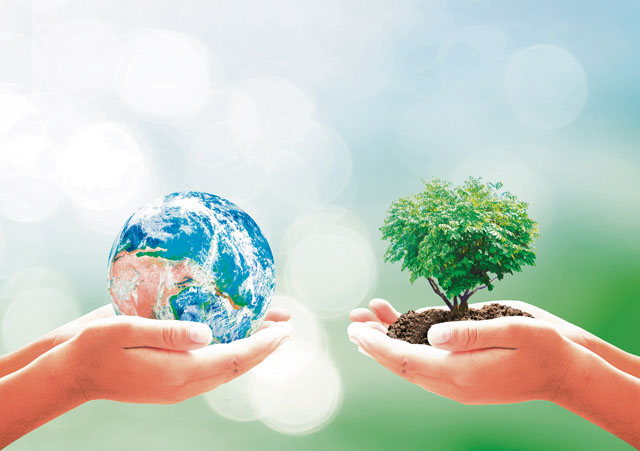
April 22 marks the anniversary of a movement started in 1970. Author Rachel Carson wrote Silent Spring. A book that brought to light some major environmental changes as well as important factors about public health. Awareness led to concern and eventually people started asking questions, particularly politicians.
Shortly after Carson’s book, U.S. Senator Gaylord Nelson from Wisconsin came up with the idea for a national day to focus on everything from pollution to the protection of living organisms. Along with Congressman Pete McCloskey and former head of the Solar Energy Research Institute, Denis Hayes, Nelson founded an organization that promotes events to create a better environment. In those moments, Earth Day was born.
The trio agreed on the date of April 22 because it usually falls between spring break and final exams for most schools. The concept is simple. The day is spent demonstrating and participating in ways to build and maintain a stable and healthy environment throughout the world. Shortly after the first Earth Day, the U.S. government created the United States Environmental Protection Agency along with the passage of three major Acts: The Clean Air Act, The Clean Water Act, and the Endangered Species Act.
Earth Day is celebrated in more than 180 countries in conjunction with over 5,000 environmental groups. It is the largest secular observance in the world with just over one billion participants.
The concept of Earth Day is meant for people to get involved and show their appreciation for the environment around them. Will you be one of those billion people to participate?
This year Earth Day falls on a Saturday which provides more flexibility and a larger choice of options for volunteers. Below are several ways you can contribute to the improvement of our global environment.

1. Learn More.
Sometimes something as simple as expanding your horizons and learning about the topic at hand can jump start bigger ideas. If you read above, you know a little bit about where Earth Day came from, but what about learning more about the environment and how you can help protect it? We live in a region of the world that largely uses wind power and solar power for resources. Make the effort to understand how such resources help our environment. You can also go beyond the local area to learn about regions you may never have thought of before such as the Arctic, deserts, or the rain forests.
2. Share What You Know.
If you’ve taken the time to learn about Earth Day and ways you can help, why not recruit others to join? Talk to your friends, coworkers, siblings, parents, and anyone else you want to educate. Knowledge is power and when more people have knowledge, that power can change the world. In fact, this year you can get a head start on educating others by joining the Earth Day Network movement. The concept focuses on promoting mandatory environmental and climate literacy along with civic engagement and sustainable economic development, which leads up to Earth Day’s 50th Anniversary in 2020.
3. Cook a Special Earth Day Meal.
In the KMC area, there are plenty of farmers’ markets and local fresh produce sold on the economy. Make an effort to plan a menu that uses locally produced foods. Do your best to use seasonal vegetables, fruits and other produce which is grown locally. Meats from local farms use fewer resources than mass-farmed meat. If you just can’t live without your meat, try to find locally produced, organic meat.
4. Act Locally, Think Globally.
Smaller acts such as recycling or cleaning up litter in your community can motivate others to follow suit. If you’ve got a bit of a green thumb (or even if you don’t), think about planting a tree or starting a garden. Trees and plants help reduce greenhouse gas emissions, clean pollution, secure soil in place to prevent erosion, and provide homes for birds, insects, and other animals.
5. Clean Out Your Closet.
This is something we can do all year long, and although you may not know it manufacturing new clothing requires both energy and water. Plus, there are many people who don’t have the money to buy their own clothing. So, take a moment (or a few) to clean out your overstuffed drawers and closets of clothes you haven’t worn in years and donate them to a local charity.
6. Reduce Waste.
According to the United Nations, we dump 2.12 million tons of waste every year. If we were to put that trash into dump trucks they would wrap around Earth 24 times. So what can we do? In addition to recycling (which you’re already doing, right?), there are several other ways to reduce the waste we produce. Buy or make Earth-friendly cleaning products. Get creative to make crafts such as birdfeeders or centerpieces out of every day items you would normally throw away. According to the Center for Sustainability at Duke University, approximately two-thirds of our household waste can be composted. Instead of throwing out your food scraps, consider starting a compost bin that will result in very rich soil for a garden.
7. Throw A Green Party
Don’t forget to celebrate all that is great with our current environment. Pull out some biodegradable silverware, purchase organic beer, cook organic food, and spend time with one another to celebrate our Earth. When we enjoy life we also want our surroundings to reflect that happiness. Community is one of the most important aspects of eco-conscious living!
For more information or for ways to get involved, visit www.Earthday.org.


